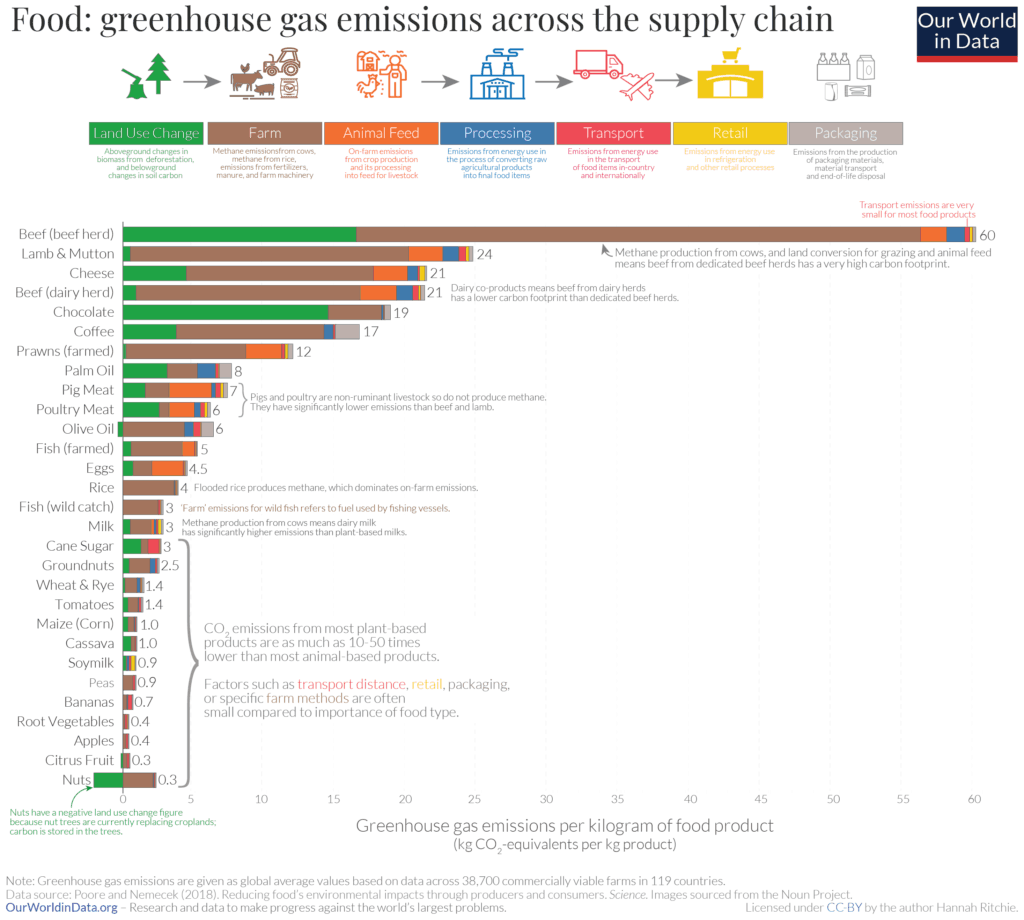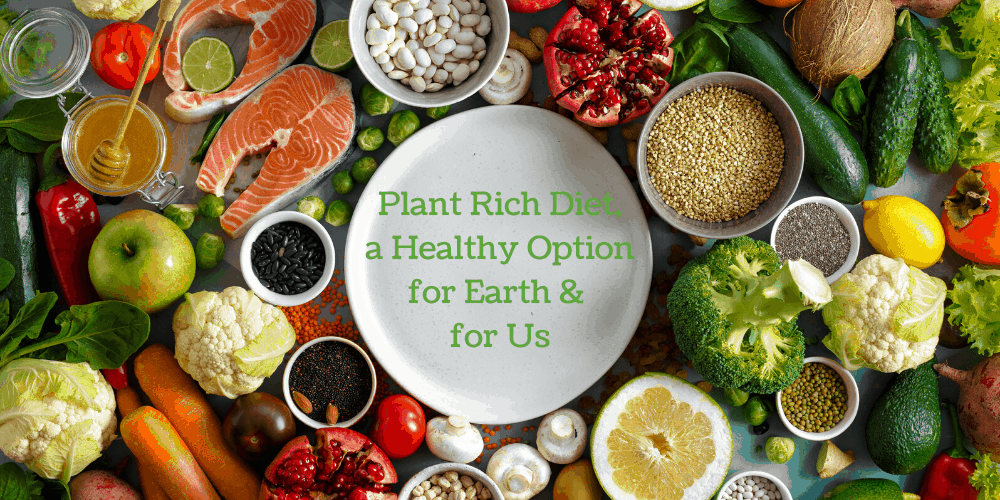A plant rich diet, does not mean only eating plant based foods. A plant rich diet means eating less meat based protein and a lower than average calorie intake. These two combined provide both a healthier option for Earth and for us.
Plant Rich Diet, a Healthy Option for Earth
The global production of food, from farm to table, emits about 13.7 gigatons (Gt) of carbon dioxide equivalents (CO2eq) collectively. By 2050, the human population is expected to reach 9.6 billion people. With the population growth, it is estimated that the current agricultural system would need to expand by 60%! (1, 2, 3)
Remember, how many gigatons of greenhouse gases that food production emits? Agriculture accounts for about 82% of the total emissions of greenhouse gases from food production; including land changed from natural ecosystems into agricultural farmland. How do we prevent more greenhouse gas emissions from food production to dampen the effects of climate change? (4)
Fortunately, Bajželj et al completed a study and found that we may be able to avoid expanding the agricultural system even with increasing demands by a much larger population. They reviewed 3 factors. First, the current agricultural system would need to increase efficiency in production. Second, food waste would need to be significantly reduced. Finally, we would need to incorporate a healthier diet. (5)
The healthier diet that the scientist developed for the study was based on recommendations from the American Heart Association and Harvard Medical School. The diet includes reduced average calorie intake and reduced meat based protein. Their healthy diet keeps portions of red meat (beef, pork, and lamb) to about 2 servings of red meat per week. They considered one serving to be about 85 grams or 3 oz. 3 oz of cooked meat is about the same size as a deck of cards. (5, 6)
Plant Rich Diet from Project Drawdown
The team of scientists at Project Drawdown reviewed all of the climate change solutions available today. A plant rich diet ranks 4th on their list of carbon dioxide reducing solutions. They estimated that if a plant rich-diet is established by 75% of the global population by 2050, this would reduce and sequester a total of 91.72 gigatons of carbon dioxide equivalents over the next 30 years. (7)
Plant rich diet from Project Drawdown is made up of the following 3 components:
3 components of a plant rich-diet:
- Daily calories to about 2,250 per person
- Decrease meat based protein consumed, especially red meat (beef, pork, lamb)
- Buy locally produced foods when able to.
The Greenhouse Gas Breakdown of Animal and Plant Based Foods
Each food group emits various levels of greenhouse gases. Generally, animal based products like meat based protein, dairy, and eggs release more greenhouse gases than plant based products. The primary greenhouse gases emitted from food production are methane, nitrous oxide, and carbon dioxide. Methane and nitrous oxide are 25 and 298 times stronger than carbon dioxide in their global warming potential, respectively. (8,9)
Animal Based Products
Animal based products, particularly from cows and sheep, release the most greenhouse gases. Cows and sheep are called ruminants because they have special stomachs that digest the plants they eat. The breakdown of plants in a ruminant’s stomach produces methane which comes out when they burp. Manure from cows, sheep, and other animals also releases methane and nitrous oxide. (9)
Nitrous oxide is also produced from fertilized soil. Microbes in the soil convert nitrogen based fertilizer or nitrogen in manure into nitrous oxide. Agriculture accounts for almost three quarters of human related nitrous oxide emissions. Finally, large amounts of carbon dioxide are released when natural ecosystems are changed into agricultural land. The agricultural land is used either for crops (including the crops to grow feed for animals), or pasture to raise the animals. This is called land use change. When natural ecosystems are converted into agricultural land carbon dioxide is released from the soil and from burning vegetation to clear the land. (10, 11)
Plant Based Products
Animal Based products are not alone in producing large amounts of greenhouse gas emissions. Methane is released from rice paddies. Nitrous oxide also comes from plant based food production. Nitrous oxide comes from the soil of crop land too. When nitrogen based fertilizer is spread over crop land, the microbes in the soil turn the nitrogen into nitrous oxide. Carbon dioxide from land use change tends to be the largest source of greenhouse gas emissions for plant based products. The four largest contributors to land use change emissions after beef and cheese are all plant based foods. They are coffee, chocolate, palm oil, and soybeans. (1, 8, 9, 11)
Below is a breakdown of the greenhouse gas emissions from food production of different foods.

Image Source: https://ourworldindata.org/food-choice-vs-eating-local Data source: Poore & Nemeck (2018), https://science.sciencemag.org/content/360/6392/987
Plant Rich Diet Decreases Greenhouse Gas Emissions
So far we have covered that our current food production emits a lot of greenhouse gases with mostly animal based foods and some plant based foods leading the pack. We have also mentioned that a wide spread adoption of a plant rich diet will reduce greenhouse gas emissions substantially. At this point, you might be asking how would a plant rich diet reduce greenhouse gas emissions?
As noted previously, if 75% of the population consumed a plant rich diet this could reduce AND sequester over 90 gigatons of carbon dioxide equivalents over the next 3 decades. How does this happen? By decreasing our own consumption of animal based products, we are decreasing demand and preventing the production of more animal based foods. With less animal based foods produced like meat, dairy, and eggs we are reducing the amount of greenhouse gases emitted. (7)
Additionally, by decreasing the amount of animal based products consumed, the less land use change occurs and as a result less carbon dioxide is released. Earlier, we reviewed that carbon dioxide is emitted from the soil of natural ecosystems when changed into agricultural land. Carbon dioxide is also produced when trees, brush, and other vegetation is burned to clear land. This occurs because the different forms of carbon stored in the plants themselves turn into carbon dioxide when burned. When carbon is stored in organic sources like soil or plants this is called carbon sequestration. Thus, the more carbon that is able to be sequestered or stored in the soil or plants by either preserving or restoring natural ecosystems, the less carbon dioxide there is in the atmosphere. (12)
Additional Environmental Impacts of Food Production
As food production is studied, more “evidence shows that food production is the largest cause of global environmental change.” (10) In addition to the greenhouse gas emissions contributing to climate change, agriculture also uses about 70% of fresh water resources. Availability of fresh water is an issue on every continent and is worsened from the effects of climate change. (10, 13, 14)
Agriculture is also the leading cause of deforestation. The loss of native forests, peatlands, wetlands, and other environments when converted for agricultural use results in a loss of biodiversity as well. The native plant and animal species that live in these natural ecosystems are either displaced or killed in land use change. Last year, the Intergovernmental Science-Policy Platform on Biodiversity and Ecosystem Services or (IPBES) reported that almost 1 million species are threatened with extinction and some within decades. (10, 15, 16)
Plant Rich Diet is Better for our Earth
Now, that we are aware of the effects food production has on climate change and the environment, we can better appreciate how a plant rich diet is a healthier option for our Earth. We will now cover how a plant rich diet is a healthier option for us.
Plant Rich Diet a Healthy Option for Us

My eyes bulged when I read this line, “Unhealthy diets are the largest global burden of disease.” Unhealthy diets leads to more diseases and deaths than “unsafe sex, alcohol, drug, and tobacco use combined.” (10) This is from a study published last year by a journal called, The Lancet. They also noted that if current diets were changed to healthy diets it is possible to prevent about 10.8-11.6 million deaths per year. (10)
In the article, the scientists outlined a healthy diet which is also more sustainable for the Earth. The healthy diet emphasizes plant based foods like fruit, vegetables, legumes, nuts, and whole grains. Also, good news for those of us who like meat and other animal based food, the healthy diet includes animal based food and even some red meat (beef, pork and lamb). Like we did before, we are going to dive a little further into how a plant rich diet is a healthy option for us. We will review the diet based on food sources of the macronutrients proteins, fats, and carbohydrates. (10,17)
Details of a Healthy Diet that is Plant Rich and Sustainable
Calorie Intake
Currently, the average calorie intake in the United States of adult males is 2800 and for adult women is 2000-2200. For the healthy reference diet, they have set their calorie intake to 2500. They note that 2500 calories is sufficient calories for a 30 year old male that weighs 70 kilograms (kg) or 154 pounds (lbs) and a 30 year old female that weighs 60 kg or 132lbs. They note that calorie intake for individuals depends on age, weight, sex, and activity level. (10)
Protein
Red Meat
For this study, they reviewed the following health effects of eating red meat. Red meat consists of beef, pork, or lamb.
- Eating processed red meat (treated with salt or other preservatives) was related with increased risk of death and heart disease. While white meat (poultry and fish) did not have a relationship to increased risk of death (10)
- Increases risk of stroke and type 2 diabetes. (10)
- Eating red meat increases the possibility of coronary heart disease more so than eating white meat (poultry and fish) or consuming nuts and legumes. (10)
- Red meat is considered a carcinogen by the International Agency for Research on Cancer. (10)
- People who eat a Mediterranean diets often live a longer life and the average meat intake for those eating a traditional Mediterranean diet is about 35g per day combined total of red meat and poultry. (10)
The group of researchers explained that because eating red meat is not required and is related to increased risk of diseases and death it may be best to not eat any red meat. They do note some studies with low amounts of red meat are not exact. The healthy diet provides a recommended amount of 7 g per day and a range of 0-14g per day. (10)
Meat from Poultry and Fish
- Eating poultry is related to healthier effects compared to eating red meat because of this, the recommend amount is higher than red meat of about 29g per day of poultry with a range of 0-58g per day of poultry. (10)
- Eating fish is associated with decreased risk of cardiovascular disease. (10)
- Fish contains Omega-3 fatty acids which is important to many parts of our own bodies including our nervous system, structure of our cells, and our heart rhythms. (10)
- One to two servings of fatty fish a week may reduce risk of heart disease related death by over 33%. (10)
- Some predatory fish like shark, swordfish, and tuna have high levels of mercury. Too much mercury in our system is toxic. There is less mercury in smaller fish. (10)
Based on the positive effects of meat from fish, they recommend about 28g per day of fish with a range of about 0-100g/day of fish. (10)
Eggs
The researchers noted that there is some debate with the health effects of eating eggs on a daily basis. They mention that eggs are a good source of protein and other nutrients. However, if protein usually consumed from eggs is eaten from plant protein sources, there may be a decreased chance of having high cholesterol. They recommend about 13g per day with a range of 0-25 grams per week. (10)
Nuts
- Nuts are associated with lower cholesterol levels, decreased risk of cardiovascular disease, type 2 diabetes and death. (10)
- Nuts are a source of polyunsaturated fats and have a lot of vitamins and minerals. (10)
- They are a calorie dense food and a good substitute for red meat as a source of protein. (10)
The recommended amount for nuts is a total of 50g per day. This is 25g per day of peanuts with a range of 0-75 grams and 25g per day from tree nuts with no range. (10)
Legumes
Legumes are from the plant family called Fabaceae and include soybeans, peanuts, beans, lentils, and peas. You may have also heard of the term pulses when talking about dried beans and peas. Pulses are the edible seeds from legume plants and are low in fat compared to legumes like soybeans and peanuts. Pulses are dry beans, dry peas, chickpeas, and lentils. (10, 18, 19)
- Legumes have been shown to reduce cholesterol levels and decrease blood pressure. (10)
- Soybeans have high concentrations of phytoestrogens and reduce risk of breast cancer. (10)
- Additional studies found that soy foods eaten by children and young adults were related with less risk of premenopausal breast cancer. (10)
With the benefits of legumes they recommend 50g of beans, lentils, and peas (pulses) per day with a range of 0-100grams and 25g per day of soy beans with a range of range of 0-50 grams. Peanuts are considered legumes (10)
Fats

Here is a quick review of the different kinds of fats.
Saturated Fats and Trans Fats are usually found in fats that are solid at room temperature like butter, animal fat, margarine, or coconut oil. (20)
Unsaturated Fats are liquid at room temperature like olive oil, peanut oil, or canola oil. Unsaturated fats include monounsaturated fats, polyunsaturated fats, and omega 3 and Omega 6 fatty acids. (20)
- There is a decreased chance of cardiovascular disease when saturated fats are replaced with unsaturated oils. (10)
- Palm oil that is more processed increases risk of a heart attack than certain soy bean oils. However, red palm oil that is less processed is a good source of precursors to vitamins and future studies may find to have less risk of heart disease. (10)
- A Mediterranean diet, high in olive oil but low in fat, over all showed less risk of cardiovascular disease. (10)
- A study that replaced dairy fat with canola oil found lower amounts of coronary heart disease. (10)
- As we have mentioned previously, Omega-3 fatty acids found in fish are associated with less risk of heart disease related death. There are also some plants that contain Omega 3 fatty acids as well and are also associated with a lower risk of coronary heart disease. Plant sources of Omega-3 fatty acids are Flax Seed and Chia Seeds. They have higher amounts while Walnuts, Soy Foods, and Canola Oil also have Omega-3s but not as high. (10, 21)
- Dairy products that are high in fat like cheese and butter may increase risk of coronary heart disease.
For fats from dairy products they allow about 250g/day. For additional fats they recommend a total of 50g with 40g coming from plant sources of unsaturated fats. (10)
Carbohydrates
Based on their review, they recommend that calories from carbohydrates are less than 60% of total calories. Of the 2500 daily calories, that they are basing the healthy diet from, 1,054 calories are from carbohydrates. For their recommended diet, carbohydrates equal about 42% of the total amount of calories. The most calories come from whole grains, with 811 calories this is over three quarters of the total calories recommended for carbohydrates. They recommend only 39 calories from starchy vegetables. The remaining amount of calories are from fruits and vegetables. (10)
Whole Grains and Starchy Vegetables
Whole grains provide a large source of beneficial calories in the healthy diet. Diets high in whole grain and fiber from whole grains are related to lower risk of coronary heart disease, and type 2 diabetes. With these benefits they recommend 232g per day of whole grains with a range in percent of total calories 0-60%. (10)
They mention refined grains like white rice, or white flour have lose nutritional value from processing. Also, increased amounts of refined grains in diets are associated with weight gain and cardiovascular disease. (10, 22)
Starchy vegetables, like potatoes, are a good source of vitamins and minerals. However, when consumed daily raise the chance of type 2 diabetes, high blood pressure, and weight gain. They recommend an amount of 50g per day with a range of 0-100g of starchy vegetables. (10)
Fruits and Vegetables
- Fruits and vegetables can prevent cardiovascular disease usually when consuming about 5 or more servings a day. (10)
- Increased vegetables in a diet can lower blood pressure and decrease chance of developing type 2 diabetes. (10)
They note that with about 5 servings of a mixture of fruits and vegetables each day may provide the most advantages. The healthy diet recommends about 200g per day of fruit and 300g per day of vegetables which is about 5 servings. (10)
Added Sugars and Sweeteners
Eating or drinking more foods with sugar, like sugar sweetened beverages is related to weight gain, type 2 diabetes, and death from cardiovascular diseases. Since sugar does not add nutrition they suggest a total of only 31 grams of both sugar and sweeteners combined. (10)
Review of Healthy Plant Rich Diet for Us
From this plant rich diet, here is a review of plant and animal sources of nutrition. Protein is mostly from plants like legumes, and nuts. Moderate protein comes from fish, some from poultry and small amounts of red meat. Majority of the fats are from unsaturated plant oils. While carbohydrates are mostly from whole grains and a daily minimum of 5 servings of fruits and vegetables. Starchy vegetables are not included as a serving of vegetables. The portions of red meat and animal based products from this plant rich diet above are significantly lower than the average diet in North America. Overall, a plant rich diet that is healthy for Earth and for us, can still include some animal based foods. (10)
Now, this is a lot to digest (pun intended, 😉) but fear not. We need food for energy and nutrients. We also need to take care of our Earth. This information above is to show us how a plant rich diet is a healthy option for Earth and for us. If you would like to know how a plant rich diet may benefit you personally, please reach out to your health care provider for additional guidance. Check out a Guide for a Plant Rich Diet for how to apply a plant rich diet to your own life.
Resources
1: Poore, J., & Nemecek, T. (2018).Reducing food’s environmental impacts through producers and consumers. Science, 360(6392), 987-992. https://science.sciencemag.org/content/360/6392/987
2: World Population Prospects, the 2012 Revision. United Nations Department of Economic and Social Affairs. (2013 June 17) Retrieved from https://www.un.org/en/development/desa/publications/world-population-prospects-the-2012-revision.html
3: World Agriculture Towards 2030/2050 The 2012 Revision. Alexandratos, N & Bruinsma J, Global Perspective Studies Team, FAO United Nations (2012 June) Retrieved from http://www.fao.org/3/a-ap106e.pdf
4: Food production is responsible for one-quarter of the world’s greenhouse gas emissions. Ritchie, H. Our World in Data (2019 November 06). Retrieved from https://ourworldindata.org/food-ghg-emissions
5: Bajželj, B., Richards, K. S., Allwood, J. M., Smith, P., Dennis, J. S., Curmi, E., & Gilligan, C. A. (2014). Importance of food-demand management for climate mitigation. Nature Climate Change, 4(10), 924–929. doi: 10.1038/nclimate2353 http://sbc.ucdavis.edu/files/202364.pdf
6: Visualize Your Portion Size, University of Rochester Medical Center. Retrieved from https://www.urmc.rochester.edu/MediaLibraries/URMCMedia/ctsi/resources/crc/documents/VisualizeYourPortionSize12-01-09.pdf
7: Technical Summary Plant-Rich Diets, Project Drawdown, (2020). Retrieved from https://www.drawdown.org/solutions/plant-rich-diets/technical-summary
8: You want to reduce the carbon footprint of your food? Focus on what you eat, not whether your food is local, Ritchie, H. Our World in Data (2020 January 24). Retrieved from https://ourworldindata.org/food-choice-vs-eating-local
9: Food Waste Footprint Impacts on Natural Resources Summary Report, FAO UN (2013). Retrieved from http://www.fao.org/3/i3347e/i3347e.pdf
10: Willett, W., Rockström, J., Loken, B., Springmann, M., Lang, T., Vermeulen, S., Garnett, T., Tilman, D., DeClerck, F., Wood, A., Jonell, M., Clark, M., Gordon, L. J., Fanzo, J., Hawkes, C., Zurayk, R., Rivera, J. A., De Vries, W., Sibanda, L. M., Afshin, A., Chaudhary, A., Herrero, M., Agustina, R., Branca, F., Lartey, A., Fan, S., Crona, B., Fox, E., Bignet, V., Troell, M., Lindahl, T., Singh, S., Cornell, S., Reddy, K.S., Narain, S., Nistar, S., & Murray, C. J. L. (2019). Food in the Anthropocene: the EAT–Lancet Commission on healthy diets from sustainable food systems. Lancet, 393, 447–492http://dx.doi.org/10.1016/S0140-6736(18)31788-4, www.thelancet.com
11: What is Nitrous Oxide and Why Is It a Climate Threat?. Inside Climate News. (2019 September 11) Retrieved from https://insideclimatenews.org/news/11092019/nitrous-oxide-climate-pollutant-explainer-greenhouse-gas-agriculture-livestock
12: Selin, N. E. (2019, January 16). Carbon sequestration. Retrieved from https://www.britannica.com/technology/carbon-sequestration
13: Climate Change and Land, Intergovernmental Panel on Climate Change, (2019 August 07). Retrieved from https://www.ipcc.ch/site/assets/uploads/2019/08/4.-SPM_Approved_Microsite_FINAL.pdf
14: Water Scarcity, United Nations Water. Retrieved from https://www.unwater.org/water-facts/scarcity/
15: Houghton, R.A., (2012) Carbon emissions and the drivers of deforestation and forest degradation in the tropics. Current Opinion in Environmental Sustainability, 4:597–603http://dx.doi.org/10.1016/j.cosust.2012.06.006, www.sciencedirect.com
16. Media Release: Nature’s Dangerous Decline ‘Unprecedented’; Species Extinction rates ‘Accelerating’ Intergovernmental Science-Policy Platform on Biodiversity and Ecosystem Services (IPBES), (2019) Retrieved from https://ipbes.net/news/Media-Release-Global-Assessment
17: Nutrition Basics, Washington State University. (xxx) Retrieved from https://mynutrition.wsu.edu/nutrition-basics
18: What are Pulses? Pulses Dry Peas, Beans, Lentils & Chickpeas. Retrieved from https://pulses.org/nap/what-are-pulses/
19: Legumes and Pulses, Harvard T.H. Chan School of Public Health, (2020). Retrieved from https://www.hsph.harvard.edu/nutritionsource/legumes-pulses/
20: Dietary fats: Know which types to choose, Mayo Clinic (2019 Feb 01) Retrieved from https://www.mayoclinic.org/healthy-lifestyle/nutrition-and-healthy-eating/in-depth/fat/art-20045550
21:Plant Sources of Omega-3s, Cleveland Clinic (2019 May 24). Retrieved from https://my.clevelandclinic.org/health/articles/17651-plant-sources-of-omega-3s
22: What’s a whole grain? A refined grain?, Whole Grains Council. Retrieved from https://wholegrainscouncil.org/whole-grains-101/whats-whole-grain-refined-grain

